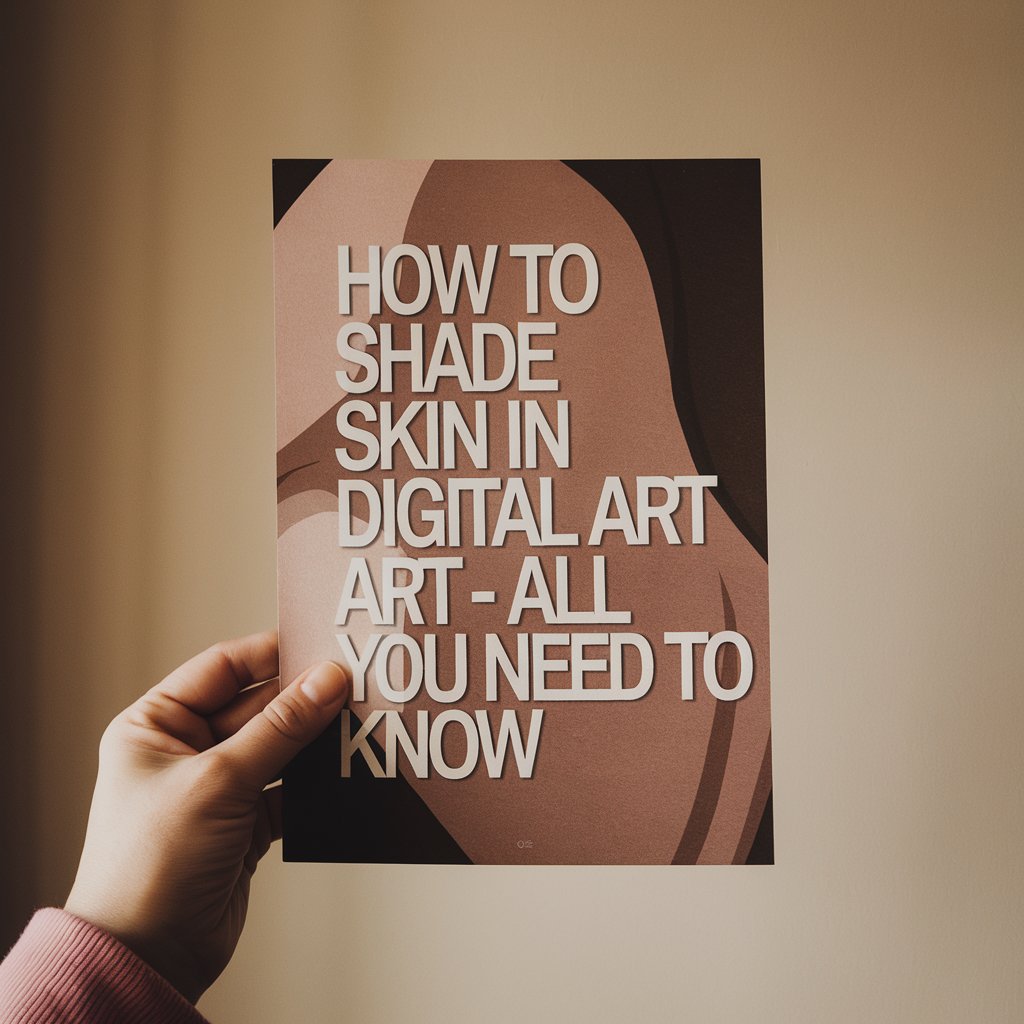Skincare
How to Shade Skin in Digital Art- All You Need to Know

Master the artwork of shading skin in virtual artwork with step-by-step tutorials, hints for realism, and strategies for stylized results.
Want to check out about Visual Effects Software
Inside the realm of digital artwork, mastering skin shading is pivotal for creating life-like and expressive characters.
The importance of nuanced pores and skin shading strategies, laying the muse for an adventure into step-by-step tutorials, practical texturing insights, and a balance between stylized and practical procedures.
Knowledge of the intricacies of shading brings characters to existence, making this skill important for artists looking for to raise the authenticity and visual effect in their digital creations.
How to Shade Skin in Digital Art- Steps

Step 1: Including Base Colorings
Begin by putting your base colorations in separate layers below the sketch or line art layers. This process is simplified with easy line art and the use of tools like the Bucket device and any Pen.
Step 2: Adding Blush and Smooth Shading with the Airbrush
Practice blush and tender shading with the use of the airbrush. Utilize a clipping mask over the bottom layer for ease and make certain the chosen color suits the skin tone. Don’t hesitate to test with distinct hues.
Step 3: Blocking in Shadows Using a Darker Color or Blending Mode
Look at light and shadow interactions at the pores and skin. Create shadows with a darker color or mixing mode, observing areas constantly in coloration just as the eyes, temples, beneath the chin, and collarbones.
Step 4: Blending
Decorate highlights with an “add(glow)” layer at 100% opacity for sharper definition. This step provides depth to the shadows and highlights.
Step 5: Blocking in a Lighter Color to Add Light
Efficiently color the chest by putting shadows interior and light on top. Use a pointy brush like Gpen to make certain right shading.
Step 6: Blending the Light In
While mixing, observe muscle shape and vary brush sizes. Use a smaller length for facial elements and a larger one for thighs, palms, and the frame. This keeps a natural and established shading appearance.
Step 7: Adding Highlights
Within the very last rendering step, add highlights on an “add(Glow)” layer set to 51% opacity. Experiment with light results, color keep away from, and environmental elements for a dynamic finish.
Enjoy the technique, experiment, and try diverse strategies until you attain pleasure using gear like the Watery Watercolor Brush.
Hey want to learn about Digital Eye Ball Also?
How to Paint Skin (Basic Tips for Stylized and Realism)

Balancing Stylized and Sensible Approaches
Whilst diving into the art of skin painting, locating the right stability between stylized and sensible processes is critical. Striking this balance lets artists carry feelings, enhance man or woman depth, and create visually fascinating digital snapshots.
Key Hints for Attaining Stylized and Sensible Pores and Skin Effects
Know-how Pores and Skin Texture:
Studying pores and skin texture is pivotal. For realism, take a look at and mirror pores, wrinkles, and imperfections. In contrast, stylized approaches would possibly simplify textures for an extra inventive, graphic sense.
Color Palette Mastery:
Practical skin tones frequently contain diffused versions and undertones. In stylized artwork, discover ambitious color choices, exaggerating shades to create specific and beautiful consequences.
Highlighting Capabilities:
In sensible portrayals, pay close interest to light and shadow on precise features. For stylized consequences, feel unfastened to accentuate functions, developing exclusive and noteworthy characters.
Expression Emphasis:
Practical skin painting involves shooting nuanced expressions and feelings. Stylized tactics can amplify expressions, making an allowance for a greater dramatic and exaggerated portrayal.
Experimenting with Brush Techniques:
Realism regularly requires meticulous brushwork to gain problematic details. In stylized artwork, embody varied brush strategies, from bold strokes to unconventional patterns, adding personality to your creations.
Gazing Inventive Inspirations:
Look at the works of artists who excel in both practical or stylized skin portray. Analyze their strategies, color selections, and use of light to comprise factors that resonate together with your vision.
With the aid of mixing those essential tips, artists can navigate seamlessly between stylized and realistic skin painting, growing a diverse range of charming virtual artwork portions.
Strategies for Natural Skin Rendering

Layered Approach:
Build depth with the aid of layering colorings and tones progressively. Begin with a base layer, including successive layers for shadows, highlights, and info. This method mimics the herbal layering of skin pigments.
Subtle Color Versions:
Real skin rendering is seldom a flat coloration. Infuse diffused versions in hue to seize the complexities of blood waft, undertones, and reflections. This attention to element complements the general realism.
High-quality Detailing:
Zoom in and recognize quality information like pores, wrinkles, and imperfections. The usage of smaller brushes meticulously depicts these elements to create a textured floor that mirrors actual skin.
Smooth Blending Strategies:
Employ tender blending to seamlessly merge colors and keep away from harsh transitions. This method contributes to a smoother and more natural appearance, mimicking the gentle transitions of light on the skin.
Examine Anatomy:
Understand the anatomy of the human face and frame. Understanding muscle structure, bone placement, and how light interacts with distinct facial features is necessary to reach sensible pores and skin tones.
Information on Skin Textures in Digital Painting
Pores and Fine Info:
Mirror the intricate patterns of pores, specifically in close-up shots. Modify brush sizes to seize each larger and smaller pore realistically.
Wrinkles and Aging Outcomes:
For portraying mature or aged pores and skin, emphasize wrinkles and creases. Take into account the route of pores and skin folds and crevices to bring the natural getting old technique convincingly.
Surface Reflections:
Mimic the reflective nice of pores and skin surfaces. Include diffused reflections to bring the play of mild at the pores and skin, growing a practical and dynamic impact.
Texture Brushes:
Experiment with texture brushes to feature range on your digital canvas. These brushes simulate the textures of pores and skin, presenting a shortcut to attaining sensible results.
Equipment and Techniques for Powerful Skin Shading
Brush Choice:
Choose brushes that facilitate clean blending and unique detailing. Gentle brushes are best for blending, while textured brushes can upload subtle information to simulate pores and imperfections.
Opacity and Glide manage:
Grasp control over brush opacity and drift. Gradual construction of color via controlled opacity ensures an extra natural transition between shadows and highlights.
Reference Imagery:
Talk to real lifestyle pictures or look at anatomy references. Looking at how mild interacts with distinctive skin tones and textures affords valuable insights for accurate shading.
Trial and Error:
Include an ordeal and errors method. Experiment with specific shading techniques, brush settings, and color versions. This iterative technique allows for nonstop refinement of your pores and skin shading talents.
By immersing yourself within the intricacies of mild, color, and translucency, you can increase your digital artwork to new heights, attaining skin shading that resonates with realism.
FAQs
What is the important thing to accomplishing realistic skin shading in virtual artwork?
Studying sensible pores and skin shading includes expertise in light sources, adopting layered shading techniques, thinking about pores and skin translucency, accounting for contemplated light, and adjusting color temperatures.
Which brushes are advocated for powerful pores and skin shading?
Pick out soft brushes for mixing and textured brushes for adding information like pores. Test with brush opacity and go with the flow to gain a herbal transition among shadows and highlights.
How can I beautify the realism of skin shading through color changes?
Modify shade temperature using making shadows cooler and highlights warmer. Introduce diffused variations in shade to imitate pores and skin translucency, and remember pondered mild for a more authentic portrayal.
What role does reference imagery play in getting to skin shading?
Reference real-life pix and anatomy guides to have a look at how mild interacts with special pores skin tones and textures. Continuous experimentation and remarks contribute to refining your pores and skin shading talents.
Conclusion
In this exploration of pores and skin shading in digital art, we’ve navigated through step-by-step tutorials, recommendations for both stylized and practical strategies, and strategies for portraying and shading.
Don’t forget the importance of balancing realism and creativity. As you embark on your artistic journey, test numerous styles and methods. Embody the nuances of light, texture, and shade to respire lifestyles into your digital pix.
Let this guide be a catalyst to your inventive evolution, encouraging continuous experimentation and boom inside the captivating realm of virtual artistry.


 Fashion2 months ago
Fashion2 months agoCarlos Alcaraz Vs Novak Djokovic Who is best in Tennis ?

 Fashion1 month ago
Fashion1 month agoUnveiling Christopher Cody: A Look at His Life Beyond the SpotlightLifeUnveiling Christopher Cody: A Look at His Life Beyond the Spotlight

 Fashion1 month ago
Fashion1 month agoJoker: folie à deux

 Tech2 weeks ago
Tech2 weeks agoTech Website Platforms

 Fashion2 months ago
Fashion2 months agoHealthy Life Wellhealthorganic: A Journey to Wholeness

 Fashion3 weeks ago
Fashion3 weeks agoExploring the Dutch Powerhouses: Calvé, Calvé Proef, Andrelon, Unilever Food Solutions, Unox, and Knorr

 Fashion2 months ago
Fashion2 months agoIbomma: Your Ticket to Telugu Movie Paradise

 Fashion5 days ago
Fashion5 days agoWhat Does Chime Mean in a Mattress Topper?
